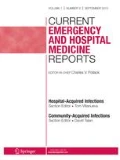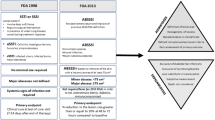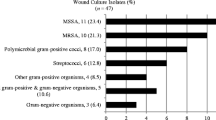Abstract
Purpose of Review
Acute skin infections are a common Emergency Department presentation. Changes in microbial resistance to antibiotics have resulted in changes in management of these infections. This paper seeks to highlight these changes in management of cellulitis and abscesses with the new emergence of methicillin-resistant Staphylococcal aureus.
Recent Findings
Soft tissue infections are most commonly caused by Streptococcus and Staphylococcus but other microbes are present in specific environments and can cause infections when patients are exposed. Simple cellulitis can be treated with beta lactams; however, purulent infections are more likely to be resistant and antibiotic choices should reflect this. Recently, novel antibiotics with extended half-lives have been created that allow for soft tissue infection treatments to be given in a single dose. These antibiotics could be useful in patients with soft tissue infection who are at risk for beta lactam resistance and will be topic of further research.
Summary
As resistance to antibiotics increases clinicians must but aware of these changes to best care for patients with skin and soft tissue infections.
Similar content being viewed by others
References
Papers of particular interest, published recently, have been highlighted as: • Of importance
• May L, Klein EY, Martinez EM, Mojica N, Miller LG. Incidence and factors associated with emergency department visits for recurrent skin and soft tissue infections in patients in California, 2005-2011. Epidemiol Infect. 2017;145:746–54. Good overview of the rates of infection
Edelsberg J, Taneja C, Zervos M, Haque N, Moore C, Reyes K, et al. Trends in US hospital admissions for skin and soft tissue infections. Emerg Infect Dis. 2009;15:1516–8.
Ellis Simonsen SM, van Orman ER, Hatch BE, Jones SS, Gren LH, Hegmann KT, et al. Cellulitis incidence in a defined population. Epidemiol Infect. 2006;134:293–9.
Kessler DO, Krantz A, Mojica M. Randomized trial comparing wound packing to no wound packing following incision and drainage of superficial skin abscesses in the pediatric emergency department. Pediatr Emerg Care. 2012;28:514–7.
Tsoraides SS, Pearl RH, Stanfill AB, Wallace LJ, Vegunta RK. Incision and loop drainage: a minimally invasive technique for subcutaneous abscess management in children. J Pediatr Surg. 2010;45:606–9.
Pickett A, Wilkinson M, Menoch M, Snell J, Yniguez R, Bulloch B. Changing incidence of methicillin-resistant Staphylococcus aureus skin abscesses in a pediatric emergency department. Pediatr Emerg Care. 2009;25:831–4.
Moran GJ, Amii RN, Abrahamian FM, Talan DA. Methicillin-resistant Staphylococcus aureus in community-acquired skin infections. Emerg Infect Dis. 2005;11:928–30.
• Stevens DL, Bisno AL, Chambers HF, Dellinger EP, Goldstein EJ, Gorbach SL, et al. Infectious Diseases Society of, Practice guidelines for the diagnosis and management of skin and soft tissue infections: 2014 update by the Infectious Diseases Society of America. Clin Infect Dis. 2014;59:e10–52. Most rescent update from IDSA
Jenkins TC, Knepper BC, Jason Moore S, Saveli CC, Pawlowski SW, Perlman DM, et al. Microbiology and initial antibiotic therapy for injection drug users and non-injection drug users with cutaneous abscesses in the era of community-associated methicillin-resistant Staphylococcus aureus. Acad Emerg Med. 2015;22:993–7.
Lodise TP, Redell M, Armstrong SO, Sulham KA, Corey GR. Efficacy and safety of oritavancin relative to vancomycin for patients with acute bacterial skin and skin structure infections (ABSSSI) in the outpatient setting: results from the solo clinical trials. Open Forum Infect Dis. 2017;4:ofw274.
• Jensen IS, Lodise TP, Fan W, Wu C, Cyr PL, Nicolau DP, et al. Use of oritavancin in acute bacterial skin and skin structure infections patients receiving intravenous antibiotics: a US hospital budget impact analysis. Clin Drug Inv. 2016;36:157–68. Intreseting analysis of the economics of the use of long acting antibiotics
Bowen AC, Mahe A, Hay RJ, Andrews RM, Steer AC, Tong SY, et al. The global epidemiology of impetigo: a systematic review of the population prevalence of impetigo and pyoderma. PLoS One. 2015;10:e0136789.
Pereira LB. Impetigo - review. An Bras Dermatol. 2014;89:293–9.
Stevens DL, Bryant AE. Impetigo, erysipelas and cellulitis, In: J.J. Ferretti, D.L. Stevens, V.A. Fischetti (Eds.) Streptococcus pyogenes: basic biology to clinical manifestations, Oklahoma City (OK), 2016.
Nweze N, Parsikia A, Ahuja R, Joshi ART. Axillary hidradenitis: risk factors for recurrence after surgical excision in 214 patients. Am Surg. 2018;84:422–7.
Saunte DML, Jemec GBE. Hidradenitis suppurativa: advances in diagnosis and treatment. JAMA. 2017;318:2019–32.
Robert E, Bodin F, Paul C, Konstantinou MP, Gall Y, Grolleau JL, et al. Non-surgical treatments for hidradenitis suppurativa: a systematic review. Ann Chir Plast Esthet. 2017;62:274–94.
Bhide A, Nama V, Patel S, Kalu E. Microbiology of cysts/abscesses of Bartholin’s gland: review of empirical antibiotic therapy against microbial culture. J Obstet Gynaecol. 2010;30:701–3.
Brook I. Aerobic and anaerobic microbiology of Bartholin’s abscess. Surg Gynecol Obstet. 1989;169:32–4.
Surrell JA. Pilonidal disease. Surg Clin North Am. 1994;74:1309–15.
Brook I. Microbiology of infected pilonidal sinuses. J Clin Pathol. 1989;42:1140–2.
Stauffer VK, Luedi MM, Kauf P, Schmid M, Diekmann M, Wieferich K, et al. Common surgical procedures in pilonidal sinus disease: a meta-analysis, merged data analysis, and comprehensive study on recurrence. Sci Rep. 2018;8:3058.
Author information
Authors and Affiliations
Corresponding author
Ethics declarations
Conflict of Interest
The author declares that there is no conflict of interest.
Human and Animal Rights and Informed Consent
This article does not contain any studies with human or animal subjects performed by any of the authors.
Additional information
This article is part of the Topical Collection on Infectious Disease.
Rights and permissions
About this article
Cite this article
Schrock, J.W. Emergency Department Management of Acute Bacterial Skin and Soft Tissue Infections. Curr Emerg Hosp Med Rep 6, 162–165 (2018). https://doi.org/10.1007/s40138-018-0172-7
Published:
Issue Date:
DOI: https://doi.org/10.1007/s40138-018-0172-7




